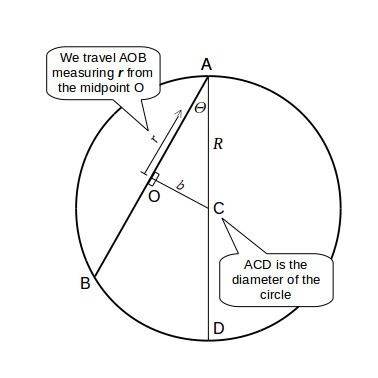 | ||
A gravity train is a theoretical means of transportation intended to go between two points on the surface of a sphere, following a straight tunnel that goes directly from one point to the other through the interior of the sphere.
Contents
- Objections
- Origin of the concept
- Mathematical considerations
- Mathematical derivation
- Diametric path to antipodes
- Straight path between two arbitrary points
- Independence from radius of planet
- In fiction
- References
In a large body such as a planet, this train could be left to accelerate using just the force of gravity, since, during the first half of the trip (from the point of departure until the middle), the downward pull towards the center of gravity would pull it towards the destination. During the second half of the trip, the acceleration would be in the opposite direction relative to the trajectory, but (ignoring the effects of friction) the speed acquired before would be enough to cancel this deceleration exactly (so that the train would reach its destination with speed equal to zero).
Objections
In reality, there are two reasons gravity trains do not exist. First, a lengthy transit distance would pierce the Earth's mantle and traverse a region where rock is more fluid than solid. No materials are known that would withstand the tremendous heat and pressure in the inner core. Temperature is estimated as 5,700 K (5,430 °C; 9,800 °F), and pressure as high as about 330 to 360 gigapascals (3,300,000 to 3,600,000 atm). Secondly, frictional losses would be significant. Rolling friction losses could be reduced by using a magnetically levitated train. However, unless all air is evacuated from the tunnel, frictional losses due to air resistance would render the gravity train unusable. Evacuating the atmosphere to make it a vactrain would eliminate this drag but would require additional power. Such objections would not apply for solid planets and moons that do not have an atmosphere.
Origin of the concept
In the 17th century, British scientist Robert Hooke presented the idea of an object accelerating inside a planet in a letter to Isaac Newton. A gravity train project was seriously presented to the Paris Academy of Sciences in the 19th century. The same idea was proposed, without calculation, by Lewis Carroll in 1893 in Sylvie and Bruno Concluded. The idea was rediscovered in the 1960s when physicist Paul Cooper published a paper in the American Journal of Physics suggesting that gravity trains be considered for a future transportation project.
Mathematical considerations
Under the assumption of a spherical planet with uniform density, and ignoring relativistic effects as well as friction, a gravity train has the following properties:
For gravity trains between points which are not the antipodes of each other, the following hold:
On the planet Earth specifically, a gravity train has the following parameters:
To put some numbers in perspective, the deepest current bore hole is the Kola Superdeep Borehole with a true depth of 12,262 meters. While to cover a distance between London and Paris (350 km) via a hypocycloidical path would need the creation of a 55,704-metre-deep hole. This depth isn't only 4.5 times as deep; it will also already need a tunnel that passes inside the Earth's mantle.
Mathematical derivation
Using the approximations that the Earth is perfectly spherical and of uniform density
On the surface,
Diametric path to antipodes
In the case of a straight line through the center of the Earth, the acceleration of the body is equal to that of gravity: it is falling freely straight down. We start falling the surface, so at time
Differentiating twice:
where
In this case
The travel time to the antipodes is half of one cycle of this oscillator, that is the time for the argument to
Straight path between two arbitrary points
For the more general case of the straight line path between any two points on the surface of a sphere we calculate the acceleration of the body as it moves frictionlessly along its straight path.
The body travels along AOB, O being the midpoint of the path, and the closest point to the center of the Earth on this path. At distance
The resulting acceleration on the body, because is it on a frictionless inclined surface, is
But
which is exactly the same for this new
The time constant
Independence from radius of planet
The time constant
which depends only on the gravitational constant and
In fiction
The 1914 book Tik-Tok of Oz has a tube, that passed from Oz, through the center of the earth, emerging in the country of the Great Jinjin, Tittiti-Hoochoo. In the 2012 movie Total Recall, a gravity train is used to commute between Western Europe and Australia. In the game Super Mario Galaxy, there are a few holes that Mario can jump through to illustrate the gravity train effect.
